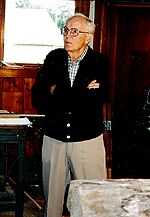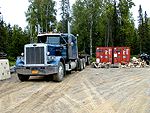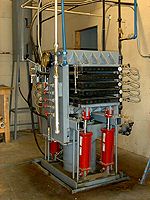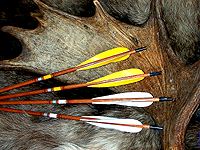


Forgewood Arrows are manufactured today, much in the same way they were originally back in the 1960's when Sweetland Products were making them (Bill Sweetland shown in photo). The same machinery has been restored and upgraded, along with some additional modern equipment, to create a similar high quality compressed hunting arrow, considered by most to be 'the best' wooden arrow shaft on the market. Those original Sweetland Forgewood Cedar arrows are still valued by collectors of Archery History.

(View from Log Yard at Kake Alaska where materials are gathered each year)
Alaska Frontier Archery has the exclusive rights to the Forgewood Technology and keeps the exact process behind closed doors, so to speak. Other arrow manufacturers may claim to make a compressed arrow yet none use a complete compression process like ours. Some run their shafting through various smaller sized swedges, producing an outer layer of compressed material. Forgewood is a process were a tapered board is compressed to 3 times its natural density on the front and 1.8 times on the back. 
(Large old growth ends from the log yard are selected for clear and straight grain)
 Our process begins with large diameter trees, 36" or bigger, of very tight grain and perfectly straight and clear, cut to 3 ft. and split into firewood type bolts. Several years of testing have gone into our decision on which Alaskan wood type to settle on for our arrows. Those tried have been Sitka Spruce, Yellow Cedar, Mtn. Hemlock and Alaskan Poplar. Each of these have been found to make very good Forgewood arrows, yet the Mtn. Hemlock has proven to be the best. A higher percentage of straightness and excellent flight character has made this Alaskan grown tree our favorite. To our knowledge, know one has offered Hemlock as an arrow wood up until this time.
Our process begins with large diameter trees, 36" or bigger, of very tight grain and perfectly straight and clear, cut to 3 ft. and split into firewood type bolts. Several years of testing have gone into our decision on which Alaskan wood type to settle on for our arrows. Those tried have been Sitka Spruce, Yellow Cedar, Mtn. Hemlock and Alaskan Poplar. Each of these have been found to make very good Forgewood arrows, yet the Mtn. Hemlock has proven to be the best. A higher percentage of straightness and excellent flight character has made this Alaskan grown tree our favorite. To our knowledge, know one has offered Hemlock as an arrow wood up until this time. 
(Splitting into bolts)
 When these Hemlock bolts arrive in the yard they are immediately sealed on the ends to prevent checking and stacked on pallets under cover from the weather. These bolts are next ran through a special saw and cut exactly parallel to the grain and in a taper starting at 1 1/8 and tapering to 5/8, ripped square on one side and trimmed to 32". The ends are sealed again to prevent checking, and stacked to dry to a given moisture content.
When these Hemlock bolts arrive in the yard they are immediately sealed on the ends to prevent checking and stacked on pallets under cover from the weather. These bolts are next ran through a special saw and cut exactly parallel to the grain and in a taper starting at 1 1/8 and tapering to 5/8, ripped square on one side and trimmed to 32". The ends are sealed again to prevent checking, and stacked to dry to a given moisture content.
When the material has been properly dried, it then is Forged equally to 3/8 of and inch which creates a material that is 3 times as dense on one end ( the point end ) and tapers to1.8 times on the back (nock end). This flat stock is then moved to a drying room where the moisture content is taken even lower to prepare it for machining and also to allow the material to stabilize from the Forging process. 
Once the Forged material is ready it is ran through a gang saw and cut to 3/8" squares in preparation for doweling. Our arrows are machined to 5/16 and then graded for straightness. Only those shafts that are naturally straight are chosen as 'Premium BattleShafts', the criteria being, perfectly straight, no machine flaws, and parallel grain orientation.
Shafts are then run through a round pole sander and given a polish finish.
From here the arrow shafts go to the grading area where each is spined to within 5 pounds and then weighed to within 20 grains.
 All our raw shafting is stored in polly bags to make sure the spine and weight remains the same. Forgewood shafts run from 50# in spine, all the way up to 100# in spine. Because we have the ability to adjust the density of the material, no spine group is unattainable. Weight ranges from 500 grains to 800 grains on a 32 inch shaft, averaging about 20 grains per inch. Your finished arrow can range anywhere from 575 gr. to 1000 gr. if you choose, but on the average, mopst are between 600 and 700 grains.
All our raw shafting is stored in polly bags to make sure the spine and weight remains the same. Forgewood shafts run from 50# in spine, all the way up to 100# in spine. Because we have the ability to adjust the density of the material, no spine group is unattainable. Weight ranges from 500 grains to 800 grains on a 32 inch shaft, averaging about 20 grains per inch. Your finished arrow can range anywhere from 575 gr. to 1000 gr. if you choose, but on the average, mopst are between 600 and 700 grains.

A.F.A is proud to bring back the Forgewood Arrow, and we will strive to achieve the same high quality that made the original Sweetland Forgewood Cedar Arrows, a remembered name in traditional archery.
E-Mail to:alaskatanman@icloud.com Back to AFA Home Page